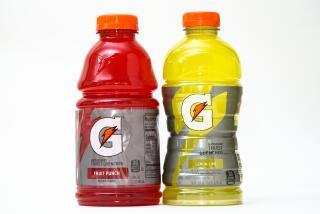Heinz expects to see growth in emerging markets
- Share via
Question: As a longtime shareholder of H.J. Heinz Co., I would like to know if I should continue to hold it.
Answer: The impetus for this global company’s growth is expected to be a developing taste in emerging markets for Heinz baby food, ketchup and other packaged foods.
The Pittsburgh company — which also makes sauces, frozen food, soups, beans and pasta meals — has made significant sales gains in Brazil, Russia and Indonesia, and expects more than 20% of sales in the current fiscal year to come from emerging economies.
The company is also pursuing the huge Chinese and Indian markets as it seeks to avoid becoming dependent on one country.
Along with great promise, however, such markets carry significant economic, political and currency risk, and are magnets for many other companies pursuing similar strategies.
Despite rising commodity costs that required raising its product prices, Heinz posted a 14% increase in net income to $990 million in the fiscal year that ended April 27, as the company’s sales rose 2% to $10.7 billion.
Profitability doesn’t come easily. In May the company said it would eliminate 800 to 1,000 jobs worldwide, consolidate its supply chain and close five factories, including two in the U.S., leaving Heinz with 76 factories globally.
After gaining 16% last year and 14% in 2009, shares of Heinz are up 8.7% this year — although they were reportedly downgraded this month by Goldman, Sachs & Co., which said the 142-year-old company hadn’t invested enough in marketing to fight discount competitors in industrialized countries and hadn’t introduced a sufficient number of successful new products in the U.S.
Overall, Wall Street analyst ratings of Heinz consist of three “strong buys,” five “buys” and 11 “holds,” according to Thomson Reuters.
Growth fund has good long-term results
Question: I would like your opinion on Aston/Montag & Caldwell Growth.
Answer: The long-term results of this low-volatility, low-turnover mutual fund are more impressive than its returns of the last few years.
The $3.2-billion portfolio’s Class N shares have gained 12% in total return in the last 12 months to rank in the lowest one-sixth of large-cap growth funds, and its three-year 0.9% annualized loss ranks in the bottom half of the category. But the fund’s five-year annualized total return of 4.7% is in the group’s top one-fourth.
“Because the fund holds very blue-chip, high-quality, growth stocks,” it tends to underperform when the market is rising, said David Kathman, mutual fund analyst at Morningstar Inc. “But it does do well when markets are jittery and people want safety from relatively stable growth stocks.”
The fund’s managers favor shares of large companies with earnings growing at least 10% a year, but they also consider price in their stock selection and think about selling a company if its share price reaches a 20% premium to what they consider to be its intrinsic value.
Portfolio manager Ron Canakaris has been in charge of the fund since its 1994 inception.
There is no sales charge, or load, on purchases of fund shares, but there is a $2,500 minimum initial investment. The fund last reported incurring annual expenses equal to 1.08% of its assets.
Andrew Leckey answers questions only through the column. Write to him at yourmoney@tribune.com.
More to Read
Inside the business of entertainment
The Wide Shot brings you news, analysis and insights on everything from streaming wars to production — and what it all means for the future.
You may occasionally receive promotional content from the Los Angeles Times.










